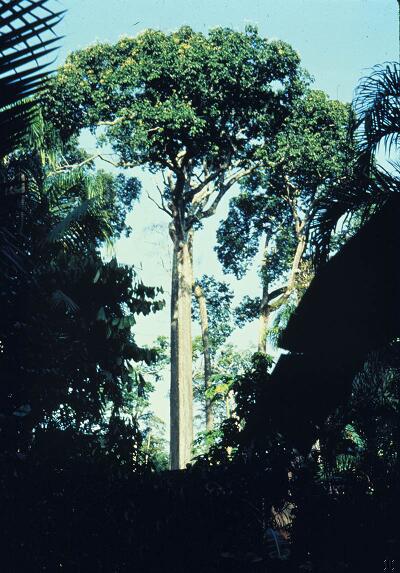Lecythidaceae
Bertholletia excelsa (Bonpl.) Miers

Kingdom: Plantae Rank: Species Parent: Bertholletia Status: Valid
Common Names:
- Brazil nut, Para nut - English, United States of America
- castaña - Spanish, Bolivia, Peru
Taxonomic Classification
Classification: Morphological diagnosis same as for the genus. The authorship of this species has been attributed to Humboldt and Bonpland, but the epithet should be credited to Bonpland alone. Although there is considerable variation in fruit shape and size there is no justification for recognizing more than one species of Bertholletia.
Morphological Description
Diagnosis: Betholletia excelsa is distinguished by oblong leaves with a whitish cast on the abaxial surface caused by microscopic cuticular papillae; a two-lobed calyx at anthesis; petals that are tightly pressed to the androecial hood for their lower half and then curled under at their apices; hard woody fruits that fall to the ground with the seeds inside; and seeds with a boney testa and no apparent cotyledons.
Vegetative Morphology
Habit: Trees, canopy or emergent, to 50 m tall. Trunks not buttressed. Bark fissured.
Leaves: Leaves with petioles 20-35 mm long; blades 17-36 x 6.5-15.4 cm, oblong, glabrous adaxially, with cuticular papillae abaxially, these giving leaves whitish cast abaxially; domatia absent; base rounded; margins entire to slightly crenulate, undulate; apex apiculate; secondary veins in 25-45 pairs.
Exudate: Reddish sap.
Reproductive Morphology
Inflorescence: Inflorescences terminal or axillary, spikes or paniculate arrangements of spikes the rachises without stellate trichomes; pedicels nearly absent.
Flowers: Flowers ca. 3 cm diam.; petals pale yellow to white; androecial hood white with yellow at entrance into flower
Fruit: Fruits 10-12.5 (16) cm diam.
Seeds: Seeds 10-25 per fruit.
Other
Uses: Brazil nuts are harvested for their edible seeds.
Distribution: Guyana and Amazonian Colombia, Venezuela, Peru, Brazil, and Bolivia. Bertholletia excelsa may also occur naturally in Surinam and French Guiana but all collections from these two countries are most likely from cultivated trees. Poiteau. in 1825 stated that Brazil nut trees had been cultivated in French Guiana for a long time before his visit, and that many of the home gardens in Cayenne had Brazil nut trees. He added that large quantities of Brazil nuts were brought from Pará to Cayenne under the name of touka. Brazil nut trees are cultivated in botanical gardens far outside their natural range, and minor plantations have been established in Malaysia and Ghana..
Ecology: Bertholletia excelsa favors non-flooded (terra firme) forests in areas with a three- to five-month long dry season. Trees of B. excelsa occur in stands known as manchales in Peru and castanhais in Brazil. Densities of Brazil nut trees vary considerably throughout Amazonia; in eastern Amazonian Brazil, twenty-six reproductive trees per hectare have been found, while in other areas as few as one tree over 10 cm DBH in a 100 hectare plot have been documented.
Chromosome Number: x = 17
Notes: Phenology: Toward the end of the rainy season the leaves of Brazil nut trees begin to fall. The new growth flushes from directly below the inflorescences of the previous year, and the new inflorescences are produced at the apex of the current growth flush. Large numbers of flowers are produced daily over a relatively long period. It takes long as 15 months for the fruits to develop after they have been set. Without special treatment, the seeds take from 12 to 18 months to germinate because of their boney seed coat. The seeds are dispersed, for the most part, by agoutis (Dasyprocta sp.).
Typification
Type Citation: Pl. Aequinoct. 1: 122-127, t. 36. 1807.
Basionym: Not applicable
Basionym Citation: Not aplicable
Type Locality: Venezuela. Amazonas: without specific locality, no date (st).
Type Collection: Humboldt & Bonpland s.n.
Types Deposited at: Holotype: P; Isotypes: B-Herb. Willdenow, P-1010
Other Published Figures: Prance, G. T. 1990. Fl. Neotrop. Monogr. 21(II): fig. 45 – habit., fl, fr, seed, seedling.